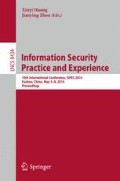Abstract
Botnet has become one of the most serious threats to Internet security. According to detection location, existing approaches can be classified into two categories: host-based, and network-based. Among host-based approaches, behavior-based are more practical and effective because they can detect the specific malicious process. However, most of these approaches target on conventional single process bot. If a bot is separated into two or more processes, they will be less effective. In this paper, we propose a new evasion mechanism of bot, multiprocess mechanism. We first identify two specific features of multiprocess bot: separating C&C connection from malicious behaviors, and assigning malicious behaviors to several processes. Then we further theoretically analyze why behavior-based bot detection approaches are less effective with multiprocess bot. After that, we present two critical challenges of implementing multiprocess bot. Then we implement a single process and multiprocess bot, and use signature and behavior detection approaches to evaluate them. The results indicate that multiprocess bot can effectively decrease the detection probability compared with single process bot. Finally we propose the possible multiprocess bot architectures and extension rules, and expect they can cover most situations.
Access this chapter
Tax calculation will be finalised at checkout
Purchases are for personal use only
Preview
Unable to display preview. Download preview PDF.
References
Silva, S.S.C., Silva, R.M.P., Pinto, R.C.G., Salles, R.M.: Botnets: A survey. Computer Networks (2012)
Goebel, J., Holz, T.: Rishi: Identify bot contaminated hosts by irc nickname evaluation. In: Proceedings of the First Conference on First Workshop on Hot Topics in Understanding Botnets, Cambridge, MA, p. 8 (2007)
Stinson, E., Mitchell, J.C.: Characterizing bots remote control behavior. In: Hämmerli, B.M., Sommer, R. (eds.) DIMVA 2007. LNCS, vol. 4579, pp. 89–108. Springer, Heidelberg (2007)
Kolbitsch, C., Comparetti, P.M., Kruegel, C., Kirda, E., Zhou, X., Wang, X.: Effective and efficient malware detection at the end host. In: Proceedings of the 18th Conference on USENIX Security Symposium, pp. 351–366. USENIX Association (2009)
Shin, S., Xu, Z., Gu, G.: Effort: Efficient and effective bot malware detection. In: 2012 Proceedings of the IEEE INFOCOM, pp. 2846–2850 (2012)
Martignoni, L., Stinson, E., Fredrikson, M., Jha, S., Mitchell, J.C.: A layered architecture for detecting malicious behaviors. In: Lippmann, R., Kirda, E., Trachtenberg, A. (eds.) RAID 2008. LNCS, vol. 5230, pp. 78–97. Springer, Heidelberg (2008)
Gu, G., Porras, P., Yegneswaran, V., Fong, M., Lee, W.: Bothunter: Detecting malware infection through ids-driven dialog correlation. In: Proceedings of 16th USENIX Security Symposium on USENIX Security Symposium, p. 12. USENIX Association (2007)
Gu, G., Perdisci, R., Zhang, J., Lee, W., et al.: Botminer: Clustering analysis of network traffic for protocol-and structure-independent botnet detection. In: Proceedings of the 17th Conference on Security Symposium, pp. 139–154 (2008)
Gu, G., Zhang, J., Lee, W.: Botsniffer: Detecting botnet command and control channels in network traffic (2008)
Ramilli, M., Bishop, M., Sun, S.: Multiprocess malware. In: 2011 6th International Conference on Malicious and Unwanted Software (MALWARE), pp. 8–13. IEEE (2011)
Fan, L., Wang, Y., Cheng, X., Li, J., Jin, S.: Privacy theft malware multi-process collaboration analysis. In: Security and Communication Networks (2013)
Ma, W., Duan, P., Liu, S., Gu, G., Liu, J.-C.: Shadow attacks: Automatically evading system-call-behavior based malware detection. Journal in Computer Virology 8(1-2), 1–13 (2012)
Microsoft security intelligence report, http://www.microsoft.com/security/sir/story/default.aspx#!zbot (accessed November 2013)
Schwartz, E.J., Avgerinos, T., Brumley, D.: All you ever wanted to know about dynamic taint analysis and forward symbolic execution (but might have been afraid to ask). In: 2010 IEEE Symposium on Security and Privacy (SP), pp. 317–331. IEEE (2010)
Park, Y., Reeves, D.S.: Identification of bot commands by run-time execution monitoring. In: Annual Computer Security Applications Conference, ACSAC 2009, pp. 321–330. IEEE (2009)
Jacob, G., Hund, R., Kruegel, C., Holz, T.: Jackstraws: Picking command and control connections from bot traffic. In: USENIX Security Symposium (2011)
http://www.nektra.com/products/deviare-api-hook-windows/ (accessed November 2013)
Liu, L., Chen, S., Yan, G., Zhang, Z.: Bottracer: Execution-based bot-like malware detection. In: Wu, T.-C., Lei, C.-L., Rijmen, V., Lee, D.-T. (eds.) ISC 2008. LNCS, vol. 5222, pp. 97–113. Springer, Heidelberg (2008)
Zander, S., Armitage, G., Branch, P.: A survey of covert channels and countermeasures in computer network protocols. IEEE Communications Surveys and Tutorials 9(3), 44–57 (2007)
Aciiçmez, O., Koç, Ç.K., Seifert, J.-P.: On the power of simple branch prediction analysis. In: Proceedings of the 2nd ACM Symposium on Information, Computer and Communications Security, pp. 312–320. ACM (2007)
Percival, C.: Cache missing for fun and profit (2005)
Binsalleeh, H., Ormerod, T., Boukhtouta, A., Sinha, P., Youssef, A., Debbabi, M., Wang, L.: On the analysis of the zeus botnet crimeware toolkit. In: 2010 Eighth Annual International Conference on Privacy Security and Trust (PST), pp. 31–38. IEEE (2010)
Author information
Authors and Affiliations
Editor information
Editors and Affiliations
Rights and permissions
Copyright information
© 2014 Springer International Publishing Switzerland
About this paper
Cite this paper
Ji, Y., He, Y., Zhu, D., Li, Q., Guo, D. (2014). A Mulitiprocess Mechanism of Evading Behavior-Based Bot Detection Approaches. In: Huang, X., Zhou, J. (eds) Information Security Practice and Experience. ISPEC 2014. Lecture Notes in Computer Science, vol 8434. Springer, Cham. https://doi.org/10.1007/978-3-319-06320-1_7
Download citation
DOI: https://doi.org/10.1007/978-3-319-06320-1_7
Publisher Name: Springer, Cham
Print ISBN: 978-3-319-06319-5
Online ISBN: 978-3-319-06320-1
eBook Packages: Computer ScienceComputer Science (R0)

